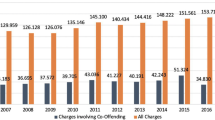Abstract
This study covers all persons under the age of 20 who were suspected of having committed a crime in the Swedish city of Borlänge (approx. 50,000 inhabitants) during the years of 1975–1977. The juveniles (575 in all) were followed up during a total of 10 years. A sociometric method based on police data was developed for studying co-offending patterns. The method was validated through a smaller number of interviews with the juveniles. This study shows that a large majority of the most delinquency active juveniles was associated with a large network of delinquent relations. The stronger the connection to this network, the more substantial, serious, and long-lasting were the delinquency and other asociality. This network also seemed to be very important with regard to the reproduction of juvenile delinquency in the municipality. At the end of the follow-up period juvenile delinquency in Borlänge had basically the same character as at the beginning, even though the juveniles included in the network were, to a large extent, new. The young offenders who were central figures in the new network had successively learned their roles from the network's old members.
Similar content being viewed by others
References
Breckenridge, S. P., and Abbott, E. (1917).The Delinquent Child and the Home, Russell Sage, New York.
Cloward, R. A., and Ohlin, L. E. (1960).Delinquency and Opportunity, Free Press, Glencoe, Ill.
Cohen, A. K. (1955).Delinquent Boys: The Culture of the Gang, Free Press, Glencoe, Ill.
Elmhorn, K. (1969).Faktisk brottslighet has skolbarn (Actual Delinquency Among School Children), SOU Stockholm, Vol. 1.
Hindelang, M. J. (1973). Causes of delinquency. A partial replication and extension.Soc. Prob. 20: 471–487.
Hirschi, T. (1969).Causes of Delinquency, University of California Press, Berkeley.
Hood, R., and Sparks, R. (1970).Key Issues in Criminology, World University Library, London.
Jonsson, G. (1969).Det sociala arvet, Tidens förlag, Stockholm.
Jungen, M. (1988). Social control theory versus differential association: A test on panel data. InJuvenile Delinquency in the Netherlands, Kugler, Amstelveen.
Klein, M. W. (1971).Street Gangs and Street Workers, Prentice-Hall, Englewood Cliffs, N.J.
Klein, M. W., and Crawford, L. Y. (1967). Groups, gangs and cohesiveness.J. Res. Crime Delinq.4: 63–75.
Matza, D. (1964).Delinquency and Drift, Wiley and Sons, New York.
Miller, W. B. (1975).Violence by Youth Gangs and Youth Groups as a Crime Problem in Major American Cities, U.S. Government Printing Office, Washington, D.C.
Persson, L. G. W. (1986).Bostadsinbrott, Bilstölder sant tillgrepp ur och från Motorfordon, Trygg Hansa, Stockholm.
Reiss, A. J., Jr. (1986). Co-offending and criminal careers. In Blumstein, A.,et al. (eds.),Criminal Careers and “Career Criminals,” Vol. 2, National Academy Press, Washington, D.C.
Sarnecki, J. (1985).Predicting Social Maladjustment, Stockholm Boys Grown Up I, Report No. 17, National Council for Crime Prevention, Stockholm.
Sarnecki, J. (1986).Delinquent Networks, Report No. 1986:1, National Council for Crime Prevention, Stockholm.
Sarnecki, J. (1989). Self-reported and recorded data on drug abuse and delinquency on 287 men in Stockholm. InCross-National Research in Self-Reported Crime and Delinquency, Kluwer Academie Press, Holland.
Shaw, C. R. (1938).Brothers in Crime, University of Chicago Press, Chicago.
Shaw, C. R., and McKay, H. D. (1931). Male juvenile delinquency as group behavior. InReport on the Causes of Crime, No. 13, National Commission on Law Observance and Administration of Justice. Washington, D.C.
Shaw, C. R., and McKay, H. D. (1942).Juvenile Delinquency and Urban Areas, University of Chicago Press, Chicago.
Short, J. F., Jr. (1957). Differential association and delinquency.Soc. Prob. 4:233–239.
Short, J. F., Jr., and Strodtback, F. L. (1974).Group Process and Gang Delinquency, University of Chicago Press, Chicago.
Sollenhag, S. (1986). Föräldrar, kamrater och den sociala anpassningen. En kausal modell. Kansli PM 9. Brottsförebyggande rådet.
Sutherland, E. H. (1939).Principles of Criminology, 3rd ed., Lippincott, Co. Philadelphia, PA.
Sutherland, E. H., and Cressey, D. R. (1955).Principles of Criminology, 5th ed., Lippincott, Chicago.
Sveri, K. (1960).Kriminalitet og alder (Criminality and Age), Almquist & Wiksell, Uppsala, Sweden.
Sveri, K. (1965). Group activity.Scand. Stud. Criminol. 1:173–85.
Thrasher, F. (1927).The Gang, University of Chicago Press, Chicago.
Torstensson, M. (1987). Drug Abusers in a Metropolitan Cohort, Research Report No 25, Department of Sociology, University of Stockholm, Stockholm.
Wiatrowski, M. D., Griswold, D. B., and Roberts, M. K. (1981). Social control theory and delinquency.Am. Sociol. Rev. 46: 525–541.
Yablonsky, L. (1962).The Violent Gang, Macmillan, New York.
Young Offenders I (1971). Unga lagöverträdare I.Undersökningsmetodik. Brottsdebut och återfall. 1956 års klientelundersökning rörande ungdomsbrottslingar (The 1956 Clientele Investigation Relating to Juvenile Delinquents), Stockholm.
Young Offenders II (1972). Gösta Carlsson. Unga lagöverträdare II.Familj, skola och samhälle i belysning av officiella data. 1956 års klientelundersökning rörande ungdomsbrottslingar (The 1956 Clientele Investigation Relating to Juvenile Delinquents), Stockholm.
Young Offenders III (1973). Birgitta Olofsson. Unga lagöverträdare III.Hem, uppfostran, skola och kamratmiljö i belysning av intervju och uppföljningsdata. 56 års klientelundersökning rörande ungdomsbrottslingar (The 56 Clientele Investigation Relating to Juvenile Delinquents), Stockholm.
Young Offenders IV (1973). Sven Ahnsjö. Unga lagöverträdare IV.Kroppslig-psykisk utveckling och status i belysning föråldraintervju och uppföljningsdata. 56 års klientelundersökning rörande ungdomsbrottslingar (The 56 Clientele Investigation Relating to Juvenile Delinquents), Stockholm.
Young Offenders V (1974). Kristina Humble, and Gitte Settergren Carlsson. Unga lagöverträdare V.Personlighet och relationer i belysning av projektiva metoder. 56 års klientelundersökning rörande ungdomsbrottslingar (56 Clientele Investigation Relating to Juvenile Delinquents), Stockholm.
Author information
Authors and Affiliations
Additional information
This paper is based on results published initially in a report entitledDelinquent Networks (Sarnecki, 1986).
Rights and permissions
About this article
Cite this article
Sarnecki, J. Delinquent networks in Sweden. J Quant Criminol 6, 31–50 (1990). https://doi.org/10.1007/BF01065288
Issue Date:
DOI: https://doi.org/10.1007/BF01065288




